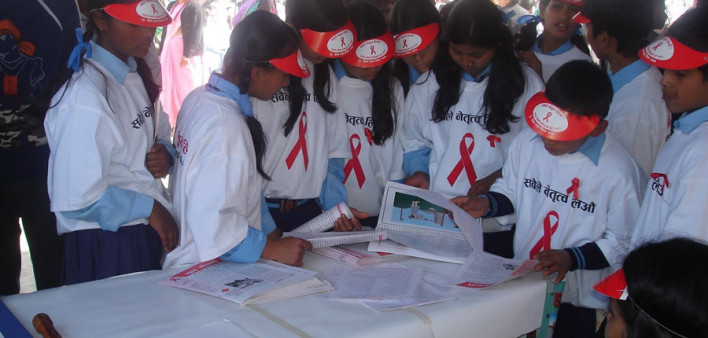This is a guest blog by Mr. Sanjeev Raj Neupane, HIV Technical Specialist at Save the Children Nepal and Mr. Anjay Kumar KC, President of
Approximately two months ago, the expectant spouse of a colleague of ours went into
The biggest risk for vertical transmission is the mother’s viral load – a measure of how much HIV is in the blood. HIV is present in breast milk just like the viral load in blood. The risk of infection is there because the virus in the milk could pass through the lining of the baby’s stomach.
The delivery was normal, without the need for assistance, and nature just took over. However, as with many pregnancies, lactation was a bit of a problem for both mother and child, but there was milk in the breasts and the child was feeding. Suddenly, into the third week after delivery/birth of the baby, the milk duct obstruction suddenly turned seriously into multiple breast abscesses that would require surgical intervention under general anesthesia.
During the pre-surgical assessment, the doctors in the hospital made them buy medical paraphernalia not required even for extremely complicated and infectious surgical procedures, making the procedure three times more expensive.
Without reading too much into this, would it be safe to assume that the doctors were simply being
The uncomfortable truth is that, here in Nepal, we still have a number of weird and wacky beliefs and attitudes of our own in the medical community about HIV-positive patients.
The uncomfortable truth is that, here in Nepal, we still have a number of weird and wacky beliefs and attitudes of our own in the medical community about HIV positive patients. Some of these practices the doctors like to hold on to, even in the face of overwhelming proven scientific evidence to the contrary. While some of these strange beliefs about HIV are harmless and downright amusing, some blow up into
U=U
The United States Center for Disease Control and Prevention (CDC) has also officially recognized the science of U=U or Undetectable = Untransmittable, which means suppressing HIV viral load through Anti-Retroviral Therapy prevents sexual transmission of HIV. CDC officials have
The influential British medical journal The Lancet HIV endorsed the idea in an editorial in November of 2017. All told, close to 700 organizations in 100 countries now agree, according to Bruce Richman, who is leading the “Undetectable = Untransmittable” (U=U) campaign credited with beginning to change public perception of HIV transmissibility [3].
U=U is a simple but hugely important global campaign based on a solid foundation of scientific evidence. It has already been successful in influencing public opinion, causing more people with HIV (and their friends and families) to comprehend that they can live long, healthy lives, have children, and never have to worry about passing on their infection to others. The CDC officially backing the science behind the campaign is another key step towards U=U being the most important message of 2017 in the fight against HIV.[4]
The science behind the campaign is clear. Between September 2010 and May
The results provide a dataset to question whether transmission with an undetectable viral load is actually possible. The results should help normalize HIV and challenge stigma and discrimination.
This research is wonderful but many people are not aware that U=U. Despite all the research, the stigma is still there—not just in sero-discordant relationships but also in society.
U=U challenges criminalization laws that, in many countries, including the US, continue to imprison hundreds of people based on assumptions of risk that these results disprove, even when condoms are used and viral load is undetectable.
Hundreds of people living with HIV (PLHIV) in the US have been charged with criminal
The results will also have a positive impact on quality of life of both HIV positive and HIV negative individuals who are in
This research is wonderful but many people are not aware that U=U. We need more education and we need to deal with the social stigma of HIV before the positive impacts of U=U can be widely felt. Despite all the research, the stigma is still there—not just in
U=U is not just a slogan. It’s a formula for eliminating HIV from the world. So if all people living with HIV in the world are identified, kept on Antiretroviral therapy and their viral load is suppressed, there will be no more transmission of HIV from one person to another and virtually the virus is eliminated from
But it is not as easy as it looks like.
First of all identifying all the people living with HIV itself is not an easy task. Many people living with HIV who are mostly from the key population don’t know that they are living with HIV. The 90-90-90 bandwagon and the lofty slogans like “Know your status, Get Tested” are helping many countries in increasing the diagnosis many countries are still failing to diagnose people living with HIV. Another problem is
Many of the PLHIV who are on ART don’t know their viral load status. Though the viral load monitoring around the world is being expanded; many PLHIVs taking ART for
Still, the message is moving mainly from people with HIV to health authorities and policymakers, rather than in the other direction.
Many health workers and medical practitioners are still not aware of the science of U=U. Like many developments in the four-decade history of HIV, this one has been slow to gain acceptance among mainstream health-care providers. Many are not aware of it or must unlearn the habit of drilling outdated safe-sex lessons into patients, as they have been doing almost since the AIDS epidemic began. HIV-positive people also must alter deeply ingrained beliefs that nothing good can come of revealing their status.
The public-health challenge now is moving from theory to implementation. Many questions arise following the information that when a person with HIV has an undetectable viral load, he has effectively no risk of transmitting the virus.
Now the challenge is to get the message out to HIV-positive people, caregivers
Still, the message is moving mainly from people with HIV to health authorities and policymakers, rather than in the other direction.
It is like the sky opens up for them. “Are you kidding?" they ask. “There’s, like, zero risk…?”
People with HIV deserve and have a right to know that “You can’t transmit the virus if you’re undetectable!”
It is like the sky opens up for them… “Are you kidding…?” they ask “There’s, like, zero
Then, finally, overcome with relief, the reality still takes time to kick in. Especially, after 35 years of stigmatization, to be able to say “I don’t feel like I’m a threat anymore, I don’t feel like I’m dirty and I don’t feel like I’m a dangerous person or carry the guilt and shame of being HIV Positive."
- https://doula.org.uk/hiv-breastfeeding-case-study/; Anne Glover; HIV and breastfeeding, a Case Study, first published in The Doula magazine.
- Division of HIV/AIDS Prevention, National Center for HIV/AIDS, Viral Hepatitis, STD, and TB Prevention, Centers for Disease Control and Prevention.
- https://www.washingtonpost.com/national/health-science/i-dont-feel-like-im-a-threat-anymore-new-hiv-guidelines-are-changing-lives/2017/11/24/a9ee84e2-cf10-11e7-a1a3-0d1e45a6de3d_story.html?noredirect=on&utm_term=.ae26961d6f46
- http://www.thelancet.com/journals/lanhiv/article/PIIS2352-3018(17)30183-2/fulltext?elsca1=etoc , November, 2017
- Activist Sean Strub, from the SERO project (seroproject.com)
- http://www.catie.ca/en/positiveside/summer-2017/uu








Comments
Comments